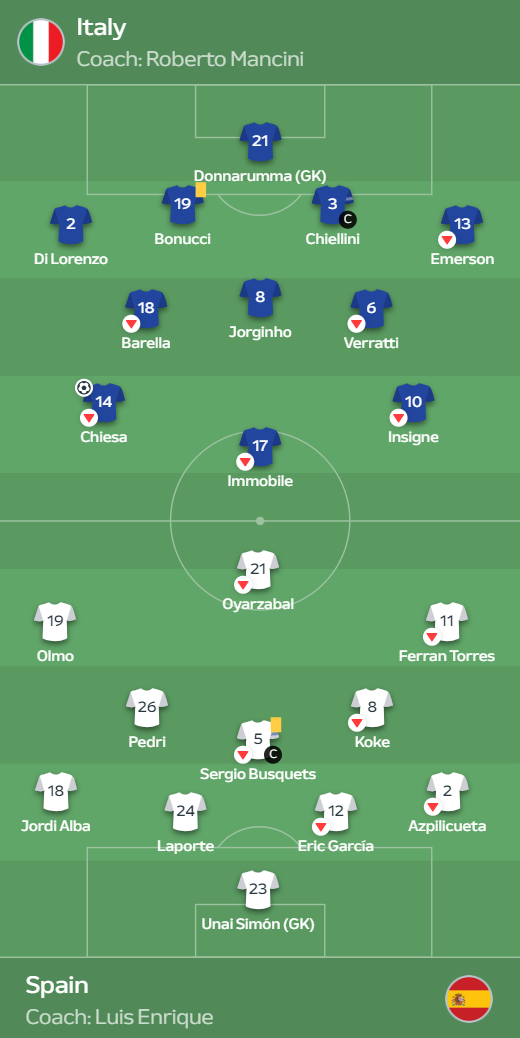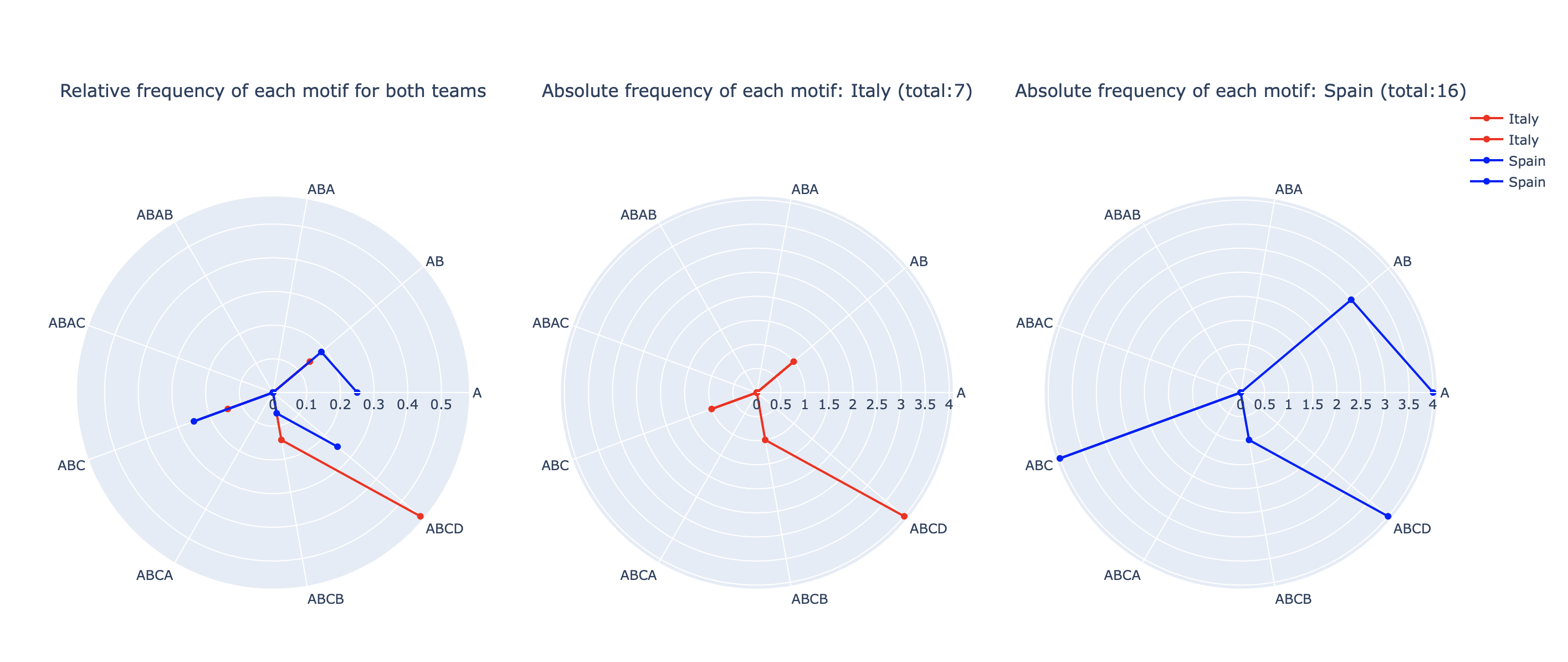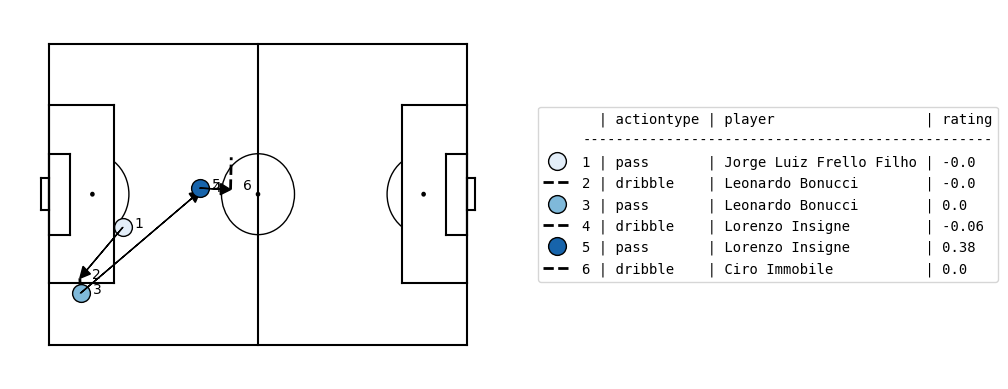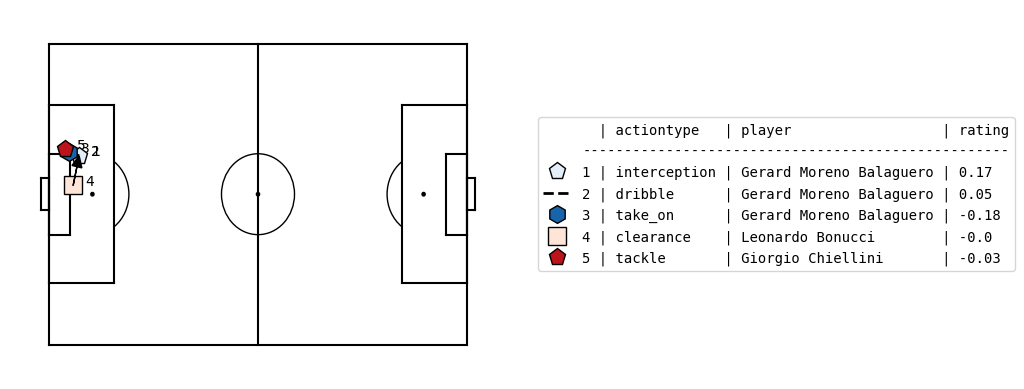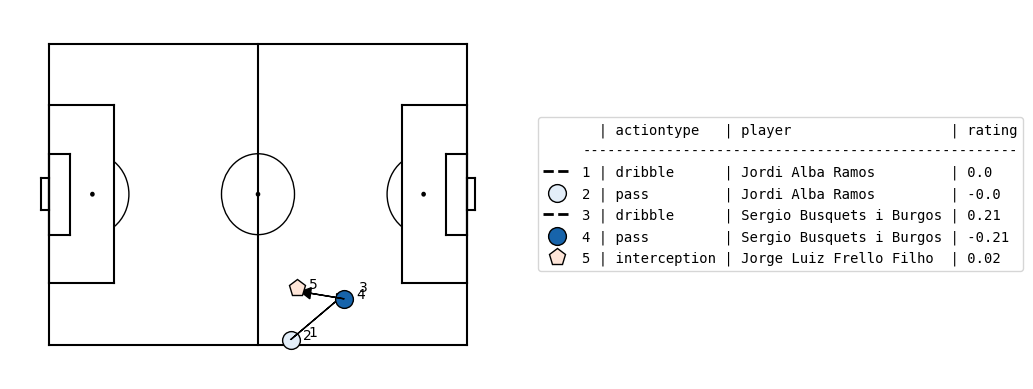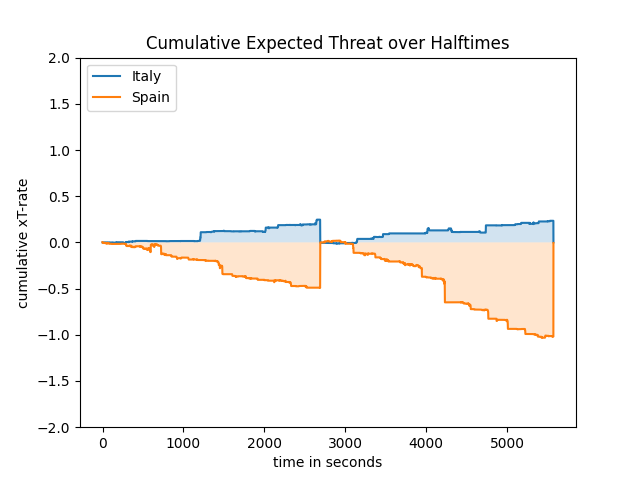Table of contents
-
Italy 1 - 1 Spain
- Before the match
- Match information
-
Analysis
- Location & Movement
- Delaunay Triangulation Before Spain's Goal
- Passing Triangles and Areas Covered
- Pass Pairs
- Ball Possession
- In-Game Probabilities
- Duels
- Passing
- VAEP
- Expected Threats
- xT Dominance
- Momentum of the Game
- Shooting
- Set Pieces
- Crosses
- Penalty Shootout
- Formations Throughout the Match from Wyscout Data
- Detecting Formations
- Fifa 21 Ratings Comparison
- UMAP Projections of Passes, Carries & Shots
Before the match
We can visualize the tallies of the last five matches of both teams in EURO 2020 to get an overview of the team performances, using the soccerbars package.
The difference is quite stark: despite being in the semi-finals, Spain has only a single victory in the first 90 minutes, and came to this stage through victories in extra time and penalties. In contrast, Italy has a perfect 5-match series with a high average.
Is this picture a result of Spain's playstyle? Should we have expected a similar display for this match, in retrospective? Or alternatively, was Italy just underperforming compared to the previous matches, that led this game to be decided with penalty shots? These are some research questions we will attend in this report.
Reproducibility
It is possible to create the above tally visualizations using the soccerbars package in Python/R, or the LaTeX implementation. See here for more details and justification. The used bash commands for these particular results are:
poetry run soccerbars "(1-0) (3-0) (0-3)* (2-1) (1-2)*" -ol -p dpi:200 -p home_color:forestgreen -p away_color:forestgreen -o "Italy.png"
poetry run soccerbars "(0-5)* (1-1) (0-0) (3-3)* (1-1)*" -ol -p dpi:200 -p home_color:crimson -p away_color:crimson -o "Spain.png"The match results are taken from the UEFA website. We only visualize the first 90 minutes, without accounting for the extra time and penalties.
Match information
Setting
The game Italy - Spain was played on Tuesday, 6th of July 2021 in the Wembley Stadium, London in the setting of the UEFA EURO 2020 semi-finals. Kickoff was at 21:00 CET, at 15°C with cloudy weather, 73% humidity and 17 km/h wind. Information was obtained from UEFA's website for Italy v Spain.
Players
| Italy | Spain | ||||||||||||||||||||||||||||||||||||||||||||||||||||||||||||||||||||||||||||||||||||||||||||||||||||||
|---|---|---|---|---|---|---|---|---|---|---|---|---|---|---|---|---|---|---|---|---|---|---|---|---|---|---|---|---|---|---|---|---|---|---|---|---|---|---|---|---|---|---|---|---|---|---|---|---|---|---|---|---|---|---|---|---|---|---|---|---|---|---|---|---|---|---|---|---|---|---|---|---|---|---|---|---|---|---|---|---|---|---|---|---|---|---|---|---|---|---|---|---|---|---|---|---|---|---|---|---|---|---|---|
|
|
|
|
||||||||||||||||||||||||||||||||||||||||||||||||||||||||||||||||||||||||||||||||||||||||||||||||||||
Line-Ups & Substitutions
Coaches
- Italy: Roberto Mancini
- Spain: Luis Enrique
Referees
- Referee: Felix Brych (GER)
- Assistant referees: Mark Borsch (GER), Stefan Lupp (GER)
- Fourth official: Sergei Karasev (RUS)
- Reserve Assistant Referee: Maksim Gavrilin (RUS)
- VAR: Marco Fritz (GER)
- Assistant VARs: Christian Dingert (GER), Christian Gittelmann (GER), Bastian Dankert (GER)
Score
The match ended 1-1 in 90 minutes, Italy won 4-2 on penalties (5-3 in total)
Full Time Score
| Italy: 1 | Spain: 1 |
|---|---|
| Federico Chiesa (60') italy-2 | Álvaro Morata (80') spain-2 |
Here, an optimized WideOpenSpaces-Pitch Control implementation was used as can be seen in this-repo. We can observe that for Italy's goal, the Spanish defense is quite rigid, blocking the long ball at first and marking the region between Chiesa and the penalty box. However, Chiesa turns this into a scoring opportunity with a remarkable long shot to the opposite corner of the goal which relies more towards personal performance of the player at that point. As for Spain's goal, the Italian defense is also packed quite densely in Italy's side of the pitch, however, Spain finds small open fields ahead of the Italian players owing to quick through balls and smart runs which penetrates the Italian defense. This can also be considered typical of Spain's playing style.
Penalties
| Italy: 4 | Spain: 2 |
|---|---|
| Manuel Locatelli |
|
| Dani Olmo |
|
| Andrea Belotti |
|
| Gerard Moreno |
|
| Leandro Bonucci |
|
| Thiago Alcántara |
|
| Federico Bernardeschi |
|
| Álvaro Morata |
|
| Jorginho |
Match Timeline
Using the Game Summary Timeline snippet ($453), we generated the timeline below.
We see a clear skew in the match, with no remarkable events in the first half, and a very dense second half. There are only three yellow cards, a number close to the EURO 2020 average 2.84 despite longer match time.
Star of the Match
Federico Chiesa of Italy. UEFA Technical Observer Aitor Karanka said "He scored the goal and was difficult to stop for Spain at times during the game."
Photo of the shoot leading to 1-0. Information obtained from UEFA technical report.
Analysis
In this section, based on the course content and the ideas presented in the final slides of the respective lecture, we add plots and analysis.
Location & Movement
For the Distances Covered, Minute Wise Average Velocities, Heatmaps and Zonal Clusters subsections, we used TRACAB tracking data.
Distances Covered
Using the distance calculation snippet ($409), we generated the table below for distances covered for each player in both teams. From the distances, one can easily identify the players who played more. Jorginho is a defensive midfield player with central midfield as his second position. He participates actively when the Italy has the ball to attack and when they defense. Therefore, it is not surprising to record that he has the most distance covered for Italy. On the other hand, Pedri is a central midfield player with attacking midfield as his second position. It is no surprise to have another midfield player to have the most distance covered for Spain.
| Italy | Spain | ||||||||||||||||||||||||||||||||||||||||||||||||||||||||||||||||||||||||||||
|---|---|---|---|---|---|---|---|---|---|---|---|---|---|---|---|---|---|---|---|---|---|---|---|---|---|---|---|---|---|---|---|---|---|---|---|---|---|---|---|---|---|---|---|---|---|---|---|---|---|---|---|---|---|---|---|---|---|---|---|---|---|---|---|---|---|---|---|---|---|---|---|---|---|---|---|---|---|
|
|
Minute Wise Average Velocities
Usinig the location, velocity and acceleration snippet ($411), we approximated the minute wise average speeds of the players, and drew a simple linear regression line to see the trend of the players' paces. The y-axis shows the velocity (m/s) and the x-axis shows the minute index the player has been on the pitch. As the goalkeeper is comperatively less interesting, to keep the tables symmetric, we excluded them. To zoom in, please click on the plot.
Italy
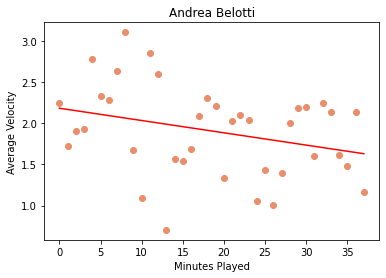 |
 |
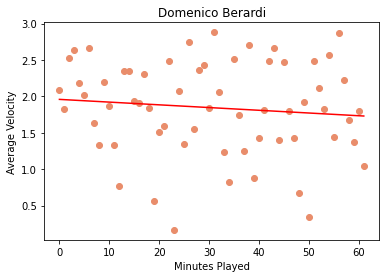 |
 |
 |
 |
 |
 |
 |
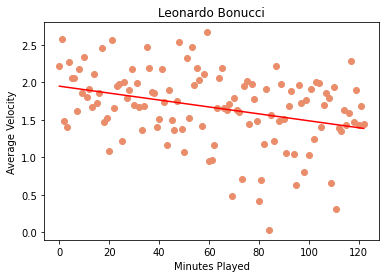 |
 |
 |
 |
 |
 |
 |
Spain
 |
 |
 |
 |
 |
 |
 |
 |
 |
 |
 |
 |
 |
 |
 |
 |
Heatmaps
Following a slightly modified version of the heatmap snippet ($405), we generated heatmaps for all players in both teams in a grid fashion. The attacking direction is towards the right side for all of the plots. We excluded the goal keepers, to keep the table 4-by-4. To see the zoomed in version of the heatmap, please click on it.
Italy
.png) |
.png) |
.png) |
.png) |
.png) |
.png) |
.png) |
.png) |
.png) |
.png) |
.png) |
.png) |
.png) |
.png) |
.png) |
.png) |
Spain
.png) |
.png) |
.png) |
.png) |
.png) |
.png) |
.png) |
.png) |
.png) |
.png) |
.png) |
.png) |
.png) |
.png) |
.png) |
.png) |
Defensive Formations
| Italy | Spain |
|---|---|
 |
 |
Here, using snippet-514, we visualized the defensive movements of both teams divided up to zones on the pitch under the events of "Pressure", "Duel", "Ball Recovery", "Clearance", "Interception" and "Block". In the plots, both teams are shown to be advancing to the upper half of the pitch with their own penalty box shown at the bottom. In agreement with the other analyses, Italy, mainly tried to defend against Spain in their own half of the pitch with a noticeable frequency in their own penalty box owing to their typical defensive gameplay. Spain, on the other hand, who had more overall possession of the game and completed passes, expanded the game into the opposition pitch and seems to have tried to set up a defensive/pressure line farther ahead in their side in the pitch and even into the Italian side.
Zonal Clusters
Using the snippet ($412), for each player, we generated the optimal K-means clusters for both teams. As the maximum number of possible clusters, we chose 5. The attacking direction is towards the right side for all of the plots. To zoom in, please click on the desired image.
Italy
.png) |
.png) |
.png) |
.png) |
.png) |
.png) |
.png) |
.png) |
.png) |
.png) |
.png) |
.png) |
.png) |
.png) |
.png) |
.png) |
Spain
.png) |
.png) |
.png) |
.png) |
.png) |
.png) |
.png) |
.png) |
.png) |
.png) |
.png) |
.png) |
.png) |
.png) |
.png) |
.png) |
Delaunay Triangulation Before Spain's Goal
As Italy's goal at the 60th minute did not come from a build-up play, we instead decided to include the Spain goal at the 80th minute by Alvaro Morata. In the plots below, one can observe the 4 passes before the goal. The green graph belongs to Spain attacking towards bottom (conversely, yellow graph belongs to Italy), red edges show if a pass is along a delaunay edge of the team, and purple edges show the "broken" edges of the opposing team's triangulation. Here we define the "brokenness" if the edge intersects with the ball trajectory. It is observable that the first two passes start with the same edge along the triangulation, and the last two, where Morata completes a one-two with Olmo, break opposing teams' delaunay edges, so that the two experienced Italian defenders, Bonucci and Chiellini, are forced out-of-position. The code for these results is a modified version of $499 and $500.
 |
 |
 |
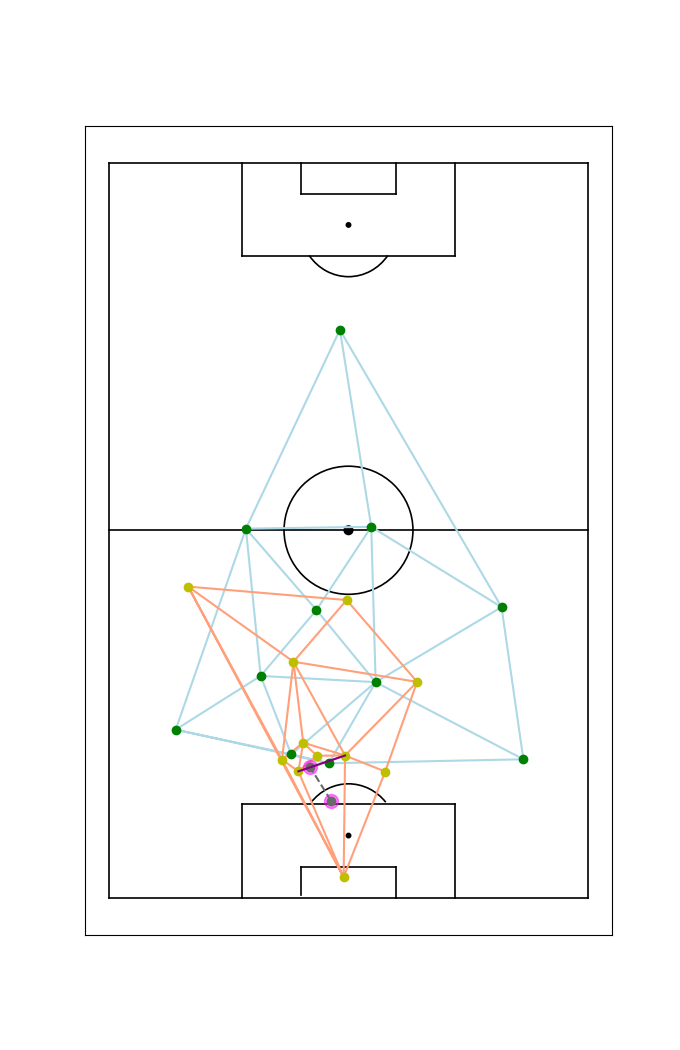 |
Passing Triangles and Areas Covered
In this subsection, we monitor the passing triangles for successful passes from both teams. By passing triangles, we refer to the following: One vertex noting the starting position of the pass (and also the passers' location), one vertex noting the end position of the pass (also the end location of the reciever), and one for the starting position of the pass. Even though the goal kicks are expected to form the largest pass triangles, as they tend not to form large angles for the edge between the the receiver's initial position and end position, they are not area-maximal. We also sampled the successful pass triangles with the largest area (for each player), and observed an interesting pattern including two defenders in the start-up play, especially when they chose to play the long-ball during build-up (see the next subsection). The relevant snippets are $499 and $500.
 |
 |
 |
 |
Both excellent defenders, one known for his passing skills rather than his marking or tackling skills, the other a "classical Italian defender" in a sense, Bonucci and Laporte were under our scope. A left footed centre-back playing on the right side (who can actually use his weak-foot as well), Aymeric Laporte, tends to send a long ball to the opposite winger, so that they can build the play from the wings. What is interesting is that this pattern arises several times, and we selected those with the largest areas to generate the table below. A better defender, rather than a player contributing to the build-up play so much (at least compared to Laporte for sure), Leonardo Bonucci, tends to make the wingers run to central zones with his long passes. Thus, one can notice the vectoral movement of the receivers in his passes are more towards the center.
Aymeric Laporte
 |
 |
 |
 |
Leonardo Bonucci
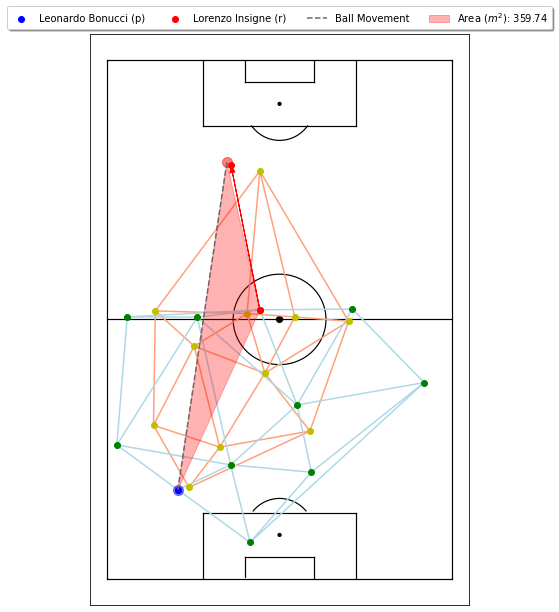 |
 |
 |
 |
Pass Pairs
We generated the pass pair plots for the successfully completed passes in the match for both teams. For both Italy and Spain, we can see that the most link-up play was between the centrebacks. One difference there is how active Donnarumma is, he frequently passed with Chiellini, despite the fact that Italy plays it long for the goal kicks. One other pattern we see is from Emerson, who instead of trying to switch the wingplay by trying for Chiesa, played frequently with Insigne.
| Italy | Spain |
|---|---|
 |
 |
Ball Possession
The development of ball possession throughout the match can be seen in the plot below. This computation is done using TRACAB ball possession data $478, and the computed final possession percentages (32%:68%) are quite close to some official UEFA sources (35%:65%). From this plot we can make many interesting observations, e.g. the very dominant phase by Spain initially, and further from the negative slope, that Spain had dominant possession throughout almost all of the game. However, as we saw in lecture, even though possession may yield an attacking phase, it doesn't always reflect the game outcome!
 |
In-Game Probabilities
Using a modified version of MTP to In-Game Probabilities Snippet $491 for all periods, we generated the in-game probabilities for our match as well. The figure shows that Italy started the match as the favorites to pass the round, and kept this position until the end of the first half. While the statistics indicate that there weren't any significant events, and Spain dominated in terms of pass counts & possesion, this plot shows Italy being the favorites until the 80th minute, the goal by Morata. Afterwards, the favorite is draw until the latest minute, and there aren't any significant jumps for both of the teams, as there aren't any red cards or goals that possibly causes such drastic probability changes.
 |
Duels
Looking at the overall picture, duels does not only display who have more physical advantage agains the other team but also provides insight about the tempo of the game. Observe that around the goal of the Federico Chiesa (60') for Italy, total number of duels has its maximum. So we can interpret that this is not a complete counter-attack instead it can be categorized as a set-game since players interact with each other a lot. Finally, Italy had the chance to score. On the other hand, Spain's goal comes with just a few passes even tough its not a counter-attack. Smartly given linking passes ended up with Alvaro Mortar's score. This is correlated with the number of duels occurred around the goal for Spain (80'). After the goal, the tempo increases as expected and the height of the last 2 bars indicating the number of duels verify that.
| Spain | Italy |
|---|---|
 |
 |
Passing
For the passing analysis, we use Statsbomb event data and modify the useful links provided in the data and tools section.
Passing Networks
For generating the passing networks, we followed the demo provided in the tutorial link. The players' locations are defined to be the median location of their passes throughout the match. The attacking direction is towards the right side for both of the teams. Feel free to also check the cleaned version of the snippet ($414)
| Spain | Italy |
|---|---|
.png) |
.png) |
Pass Clusters
Using snippet-460, we visualized the cluster centers of the passes completed by both teams throughout the match. Number of clusters, 25, was fine-tuned visually as to not give too much of a coarse representation of the passes in the overall game and at the same time make the plots visually appealing by not plotting the passes on too fine detail. Thus, the resulting plots give us clearly descriptive passing patterns followed by both teams. As we can see, Italy in overall made much less number of passes in general and most frequent passes were those between the defensive players who constitute the backbone of the Italian team. On the other hand, the Italians mostly relied on long balls to the oppositions side of the pitch and into the penalty box, which is of course how their goal in the 60th minute came to be. Additionally, they seem to have preferred the right wing more during their offensive play. The Spanish on the other hand, preferred rather short distance and more articulate passes generally around the pitch center or halfway through to the opposition side and rarely tried long balls into the penalty box. Their extensive passing efforts reflected to their high possession of course as they probably tried to control the ball at a larger portion of the pitch compared to the Italians. It might seem that compared to their high number of pass attempts outside the opposition penalty box, not a vast amount of them has actually been built up to a play into the penalty box as we see that the passes made there suddenly get much less in frequency and occupancy. However, this understanding of building the game with short passes from the center of the pitch to the penalty box indeed led the to their well-set goal at the 80th minute.
Team Sonars
For generating team wise passing sonars, we once again used this tutorial linked in the data and tools section. Note that we changed the coordinates for individuals to comply with the formation we provided in the Line-Ups section (both teams play 4-3-3).
To go over the results in a position based approach, as we expected goal keepers have one sided sonars. Since most of the time, the set-game is initiated with the pass from goalkeeper to one of the center-backs, we observe quite more bins in center-backs. For Spain, one can observe that the center-backs have the tendency to pass the ball to fullbacks for the build up where Bonucci has the tendency to play the ball vertically. Since Spain does much more passes, we expect them to be short range passes. This idea can be supported by looking at how their defensive midfield Sergio Busquets has the tendency to pass the ball to center midfield. Whereas Jorginho made more long range passes especially to Insigne. Finally, as expected, the strikers has less tendency to pass the ball vertically since they are considered as the last man in the front. Therefore almost one-sided passing sonar was expected.
| Spain | Italy |
|---|---|
 |
.png) |
Passes and Possessions per Minute
Yet another way to show Spain's dominance throughout the game. Inspired from the snippet ($471). Greens are Italians, and Reds are Spaniards. White lines corresponds to ball possession percentage per minute. Grey vertical lines correspond to goals. After Italy's goal, we see that Spain seizes the ball for nearly 5 minutes. After Spain's goal, we see that both teams want for extra time, reflected by the completed pass counts. Parallel with other analysis in this report, Spain develops the game by passing which is expected from Barcelona origined Luis Enrique. Italy loves direct play, reflected by sharp inclines and declines on ball possession percentage.
Teams animated flow velocity fields using passing data
We used this github repo linked in the data and tools section. Flow velocity fields represent the estimated steady flow in fluid dynamics.
In this particular game, the estimations for Italy is inconclusive since they do not have enough datapoints for such an evaluation, however in the case of Spain we see an obvious success in the pass flow on the right side, while the left flows seem to be "deflected".
| Spain | Italy |
|---|---|
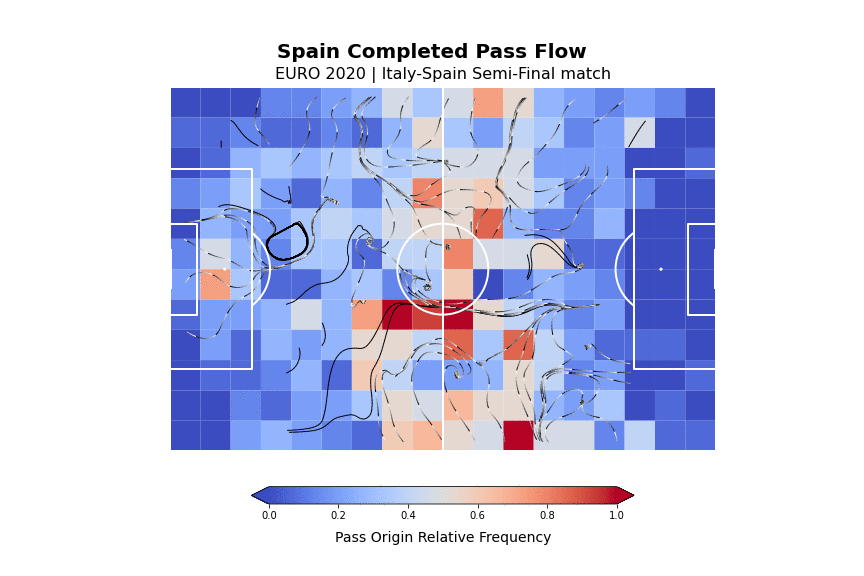 |
 |
Origin Destination Maps
Origin-destination map of all passes in the game, extracted from Statsbomb event data. Orientation is from own goal towards opponent goal in both plots. The colors represent the length of the pass in viridis color scale.
Origin-Destination Mapping (O-D Mapping) allows us to visualise geographical mobility between two set coordinates: in this case between the start point and end point of the passes. It is more explicit than just clustering passes without representing the underlying data. In this particular implementation, we overlay the clusters over the OD maps directly.
The arrows point to the cluster centers of the passes, determined via weighted Dirichlet Process Gaussian Mixture Models (maximum n=4, full covariance matrix). See Snippet $430 for the code.
| Italy - All passes | Spain - All passes |
|---|---|
.png) |
.png) |
We see some clear and expected patterns in both teams. For example, passes made on the sides of the pitch are nearly exclusively vertical. Spain expectedly have many more passes than Italy and provides a general cover of the field. However, Italy's passes has a clear right skew, also captured by GMM clusters.
| Italy - Passes under pressure | Spain - Passes under pressure |
|---|---|
 |
 |
What about passes made under pressure? When plotted, we interestingly do not see many patterns in Spain's side despite having considerably more passes -pointing that Italy was not able to create pressure on Spanish attacks, or simply Statsbomb did not classify them as such -though it is clear that they mainly attack from the right side of the pitch where they meet the most resistance. For Italy, we see an interesting asymmetry, as under pressure the leftward advances often pass backwards, while center and rightward advances in the front of the pitch moves forward, often towards the right. Indeed, Italy's only goal resulted from a similar pattern as we can see in the pitch control visualization.
Passing Motifs
Using Snippet $432, from Statsbomb event data we plotted ( with help of this tutorial ) the radar charts of the passing motifs of both teams as below.
| Normalized | Unnormalized |
|---|---|
 |
 |
Here, the first thing to notice is the dramatic difference between the amount of passing patterns completed between the two teams. Spain, who heavily base their game on triangulated and complex passing networks understandably have many more overall completed passes for each motif. Italy, who have a more defensive understanding of the game seem to have completed much less of each motif throughout the game. We notice that, there is a strong correlation in this match between these completed passes, the overall possession of Spain and created goal attempts, which seemed more favorable over those of Italy. However, these ultimate chances were either mostly out of target which may indicate issues regarding the strikers of Spain or were saved by Donnarumma who had a remarkable EURO2020 season. Another thing to notice is that, when passing motifs are normalized, both teams seem to have almost identical radar plots, indicating they both tactically preferred similar passing networks, but Spain may have put them into use slightly better as they had much more of these pass instances as can be seen from the goal of Spain at minute 80'.
In the figure above, we observe the passing motifs of Spain and Italy which explicitly led to shots. We first note that in the plots, we excluded the penalty shootout where Italy used 5 penalties and Spain used 4 penalties since they are trivially counted as passing motif 'A' and may be deceptive or uninformative. Surprisingly, we notice in the leftmost plot that both teams have followed almost identical passing motifs as they were developing an offense that led to a shot despite the imbalance in the total passes or possession of both teams. This also was the case for the passing motifs throughout the game. Hence, we may infer that both teams roughly made use of similar gameplays or passing patterns as they were searching for a goal. We can further see in this plot that while Italy mostly preferred shorter passing motifs such as 'A' or 'AB' prior to a shot, which implies strong dependence on individual player performances who are possibly offensive players, Spain made use of longer passing patterns such as 'ABCB' or 'ABCD'. This is again a perfect example of Spain's understanding of the game where they try to find a goal with long chains of passes.
VAEP
VAEP(Valuing Actions by Estimating Probabilities) enables us to assess the impact of the individual actions performed by soccer players during games. It describes individual player actions on the pitch and values any type of player action based on its impact on the game outcome while accounting for the context in which the action happened.
Following are the VAEP's for goals of Italy and Spain respectively. One can observe the flow of the game on the pitch with the related actions and the involved players.
| Italy's Goal | Spain's Goal |
|---|---|
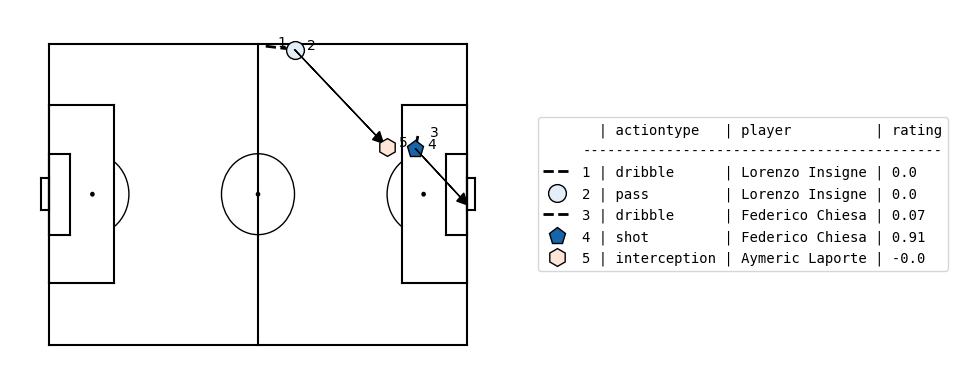 |
 |
We can observe the positions that yield the top 5 VAEPs in the game. One can note that 4 out of 5 positions belong to Italy, that means, even though it looks like Spain controlled the game from previous analysis, we can observe that critical actions were made by Italy.
We can observe the positions that yield the top 5 VAEPs in the game. Note that, playing more with the ball enables you to make mistakes since your opponent will try to steal the ball and have contra attacks. That's what happened to Spain. 4 out of 5 minimum VAEP positions belong to Spain which is not surprising when we take into consideration of ball possession.
Expected Threats
We can observe that throughout the match Spain has more expected threats. This performs a high correlation with the possession of the ball. Especially after Italy leads the game, the expected threats of Spain increases exponentially which is totally expected. In the first half, both teams tried not to take risks and analyze each other in a controlled manner. Second half was more bustling.
xT Dominance
Expected Threat, or simply xT, was first introduced by Sarah Rudd back in 2011, before being repurposed into the currently most used definition by Karun Singh in 2018. It estimates a moving shooting probability per designated grids.
As we expected, the dominance of Spain outperforms the dominance of Italy which has the similar reasoning with expected threads. Spain's mentality to keeping the ball yields such a result however as Sir Alex Ferguson mentioned, statistics are like mini-skirts, they don't reveal everything.
Momentum of the Game
1st Half:
 2nd Half:
2nd Half:
 Extra Time-1st Half:
Extra Time-1st Half:
 Extra Time-2nd Half:
Extra Time-2nd Half:

The above momentum plots for the two halves of the regular time and the two halves of the extra time are obtained by Snippet-505. In the plots, the upward columns indicate the differential xT generated by Italy and the downward ones indicate the differential xT generated by Spain. Here, the most striking observation is how much Spain had the momentum of the game for the most part. This is of course, much anticipated by their overwhelming ball possession and goal attempts. While Italy gained momentum of the game occasionally on the first half, in the 2nd half, Spain almost completely had the momentum, generating more and more chances. Italy, who adopted a defensive gameplay, managed to prevent most of these chances however let Spain take control of the game in doing so. We notice that at minute 60', as Chiesa scored from a somewhat disorganized gameplay, Spain still had the momentum. However, after the goal, Spain built up their momentum even more and got rewarded with a goal at minute 80' after which their momentum decreased gradually due to a more cautious Italian defense and probably fatigue.
Shooting
Heat map of xGs
Credits to the snippet ($492). It can be observed that the most probable outcome of the match is analyzed as 1-0 for Spain. Considering the actual score which is 1-1, we can interpret that Italy finds less critical positions compared to Spain.

Teams xG plot
We used the cumulative xG graph snippet ($417) to generate the plot below. The curves therefore represent the sums of all previous xG values up to a specific moment, and the goals are marked by a dot. The expected goal values are taken directly from the Wyscout dataset for each recorded shot in regular- and extra time.
It can be seen, that Spain had a higher cumulative xG throughout the game, resulting from both more frequent attempts, but also high-probability scoring opportunities (such as Olmo's chance in the 24th minute and Morata's goal), whereas even Italy's goal by Chiesa had relatively low xG.
xG weighted Shoot Attempt Distributions by Team
Magnitude of each shoot attempt (circle) is found by quantizing log-scaled statsbomb expected goal values into 5 bins. Unsuccessful shoots are denoted by red, while goals are by green. Penalty-shootouts are excluded from the visualization. Left side is Spain, and right side is Italy. As sensible, Chiesa's goal was harder than Morata's. Spain attempted more shoots than Italy. Spain scored its shoot with highest xG, while Italy found more clear chances than its goal.
Possession Chains Before Goals
Attacking on right side for both goals. Inspired from snippet ($439)
| Spain's Goal | Italy's Goal |
|---|---|
 |
 |
Spain's Goal 3. action (acceleration) belongs to Morata. 4. and 5. actions correspond to one-two pass, then Morata shoots.
Italy's Goal 2. action is a smart through ball to Spain penalty box, which was deflected by Spain as apparent from 3. and 4. actions. 5. action is Chiesa's touch to ball, and after 'duel', he shoots.
Set Pieces
| Spain | Italy |
|---|---|
 |
 |
Here, we can see that both teams have designated players to take the corner kicks as usual. Also, we see that defenders Bonucci and Jordi Alba in both teams have used the most free kicks which can be explained by the fact that most of the fouls taken by either team usually occur in their half of the pitch or around the center of the pitch, so both teams utilized these two center backs with offensive capabilities to initialize the gameplays to advance into the opposition side of the pitch. Another thing to notice from these charts is regarding the penalty shootout. In the 2nd half of the extra time, both coaches substitute two players, namely Bernardeschi and Morata, which is probably a tactical decision for the penalty shootouts as both players get to use a penalty shot. However, quite dramatically, Morata misses his penalty shot while Bernardeschi turns it into a goal as Italian coach Mancini would have anticipated.
Goal Kicks
Credits to snippet ($549). We can observe that number of goal kicks used by Italy is much more than Spains. This points out that Spain had much more dominance and made more shots. As we know, Italy has tall center-backs and Spain's game characteristic is based on tiki-taka mentality. Therefore, it is expected to have short ranged goal-kicks from their side.
| Italy | Spain |
|---|---|
 |
 |
Throw-ins
Credits to snippet ($549). A crucial point to note is that Spain tends to use the throw ins in a more long ranged compared to Italy. In addition to that, we can observe that there are two throw-ins which are directly to midfield whereas some others have the same tendency with smaller ranges. On the other hand, Italy's throw-ins are in general short ranged and more in number compared to Spain.
| Italy | Spain |
|---|---|
 |
 |
Free-kicks
Credits to snippet ($549). We have observed that Spain used much more free-kicks than Italy. This can be interpreted as Spain has more control over the ball and game, Italy tried to defend and naturally made more false while trying to steal the ball.
| Italy | Spain |
|---|---|
 |
 |
Crosses
Using snippet $431, we generated the crossing plots using Statsbomb event data. The successful crosses are colored orange, where as the unsuccessful ones are colored gray. Here we can see the discrepancy between match stats and the data. Considering corners are counted in websites such as BBC and ESPN, we observed that analysts hesitate to count crosses. We were able to find one betting site that also provides the cross counts as statistics: link, however, when corners are extracted from the number of crosses, we see that the website counted one Italy cross, that is not found in the data. We believe that it is registered as a long pass in the data.
 |
Penalty Shootout
This semi-final game is decided by penalty shootouts. In this analysis, we present each penalty's location, order, taker, and outcome. The goal post is created using Statsbomb's Appendix 2 Goal Coordinates. Olmo's penalty is complete outlier and as it was the first one it must be discouring for Spain. On the other hand, Italy seems to have an organized strategy to choose right side. We put the corresponding snippet here: link
Formations Throughout the Match from Wyscout Data
The following graphic generated using snippet $488 shows how the formation of the two semi-finalists changed over time according to the Wyscout data. Both teams start with a general 4-3-3 strategy, which is an offensive strategy and very flexible. Later in the match they both switch to strategies which are known for being defensive although they have the potential to be transformed into more offensive ones. Spain switches to a defensive 4-2-3-1 formation after 2 player substitutions in minute 70', followed by Italy changing their formation to 4-1-4-1 after two player substitutions in minute 73'.
Detecting Formations
The following are the computed formation clusters of our implementation of the Shaw & Glickman (2019) approach of determining actually played formations using TRACAB tracking data in our snippet $502. Since we are using significantly less data, we restrict the phases to minimum 30s and maximally 1 minute length and use a Silhouette score to determine the best number of clusters (between 2-4). We can observe many interesting things. Generally, even though both teams have a general 4-3-3 strategy (as shown in the starting XI), their actual positioning shows wide variations. More specific observations are:
- Defensive formations are more dense for both teams compared to their attacking counterparts.
- We see that when attacking, the wingbacks move up the field quite a lot, turning e.g. Spain's 4-3-3 into a 2-5-3 formation when attacking.
- On the other hand, wingers as well as more defensively oriented midfielders often fall back when defending, making e.g. Spain's 4-3-3 into a 4-2-3-1 in defensive cluster 2.
- We also observe differences within Italy's defensive strategy. We see both a 4-2-3-1 (defensive cluster 3) as well as a 4-1-4-1 (defensive cluster 4) variant employed, which likely is more useful when trying to quickly switch to the attack.
| Italy Attacking | Italy Defensive | Spain Attacking | Spain Defensive |
|---|---|---|---|
 |
 |
 |
 |
 |
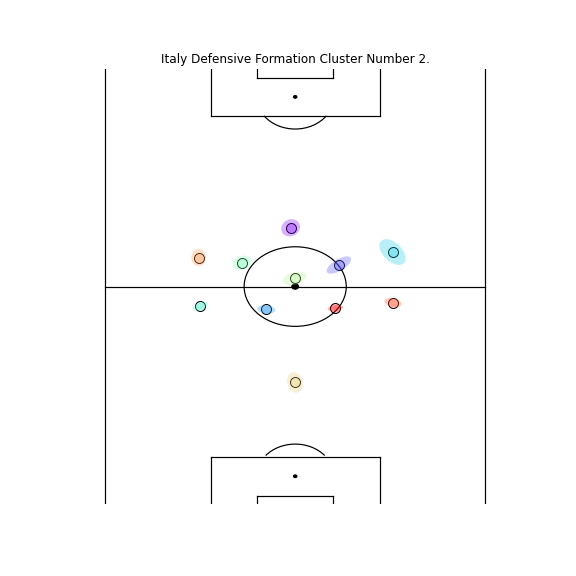 |
 |
 |
| ------ |  |
------ | ------ |
| ------ |  |
------ | ------ |
Fifa 21 Ratings Comparison
As we all know, due to COVID, tournament was held in 2021. Thus, we decided to compare line-up's player ratings in Fifa 21, instead of Fifa 20. Note that Fifa 21 ratings were released in mid-September 2020, and Fifa 22 ratings are calculated after the EURO's, with the impact of the tournament. Lucky for us, the formation both teams followed during the match was 4-3-3, hence, we were able to do a position-by-position comparison using the Fifa 21 ratings. The table can be observed below. The snippet used was $508.
 |
 |
 |
 |
 |
 |
 |
 |
 |
 |
 |
------ |
We can see that the side-by-side difference in ratings between certain matchings are quite significant, namely Veratti against Pedri, Chiellini against Garcia, Emerson against Alba and Chiesa against Oyarzabal. To begin with, Veratti at the time of the EURO was already a staple for PSG and Italy, whereas Pedri was a 19-year-old wonderkid, thus the difference is expected. At the moment, if we were managing any big club, we would definitely try our chances of signing Pedri instead of Veratti! The other two differences, are similla, one in favor of Italy the other in favor of Spain, Chiellini against Garcia, and Emerson against Alba. One player in these comparisons is world-reknown, the other is not (Garcia is a one to watch though.) But the one that we quite like is Chiesa against Oyarzabal. Mikel Oyarzabal is an excellent player, however, if one decides to do a before-after analysis for the EURO 2020, the biggest development observed would be, without a doubt, Italy's Federico Chiesa. It wouldn't be wrong if we claimed that EURO 2020 is why Chiesa is considered to be a superstar at the moment. We therefore also compared Chiesa's ratings in Fifa 2021 against Fifa 2022, to see how Fifa felt.
Federico Chiesa
Not only Chiesa's (almost) every single rating was increased, it was increased by a significant margin. Note that the x-axis is now between 0 and 16. Fifa also decided to bump-up Chiesa's potential from 84 (in Fifa 21' career mode) to 91 (in Fifa 22' career mode), showing that they forecast Federico Chiesa to become better than (in terms of rating, obviously) Mohamed Salah!
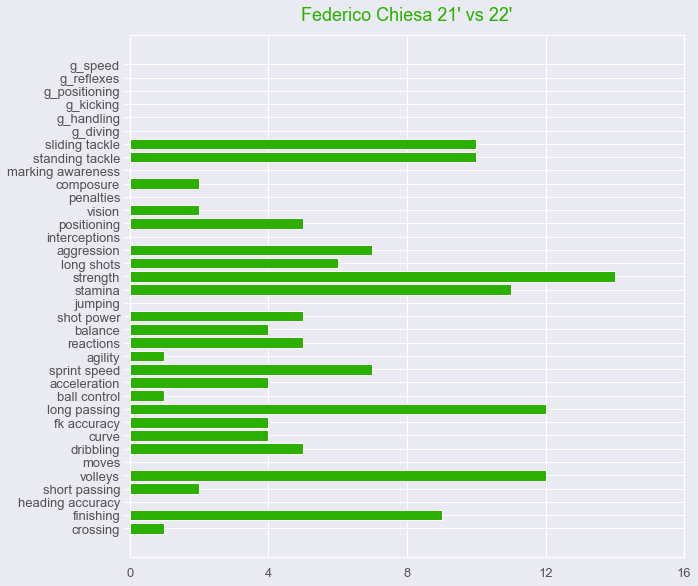 |
UMAP Projections of Passes, Carries & Shots
To compare our match statistics with Italy's and Spain's other matches up to the semi-finals, we decided to utilize all of the Statsbomb data contained in the dataset. We first took the start position (x and y), end position (x and y) and duration of the events to generate a 5-D vector. Assuming that there exists local patterns, we used UMAP (Uniform Manifold Approximation and Projection) strategy, and colored these events based on match numbers. Our main goal was to see if there exists a pattern for our match, that is locally connected and different than the other patterns from teams' earlier matches. First of all, the statistics for these events throughout the tournament can be seen in the table below, to compare them numerically before observing the UMAP projections. All the plots and statistics were generated using the snippet $578.
| Event Name | Our Match | Match 1 | Match 2 | Match 3 | Match 4 | Match 5 |
|---|---|---|---|---|---|---|
| Italy Shots | 12 | 14 | 26 | 23 | 13 | 24 |
| Italy Passes | 425 | 546 | 704 | 629 | 554 | 669 |
| Italy Carries | 341 | 493 | 529 | 535 | 396 | 569 |
| Spain Shots | 20 | 12 | 24 | 34 | 17 | 19 |
| Spain Passes | 946 | 754 | 930 | 1031 | 946 | 702 |
| Spain Carries | 811 | 642 | 705 | 919 | 738 | 536 |
The table indicates that statistically, Italy was on the passive side on this match, whereas it was rather a median game for Spain. To check the 2-D UMAP projections of these events to see if there exists a particular pattern, we generated the following plots for both teams. Match 0. purple dots demonstrate our match.
Italy
| Shot | Pass | Carry |
|---|---|---|
 |
 |
 |
We see that pass and carry events, while containing some local structures, are generally uniformly distributed across the manifold. However, when we examine the shooting manifold, we see there exists five purple dots in a close neighborhood. Going over the shooting files we observed that these correspond to shots in (107.85-108.05) to (39.85 - 40.05) in terms of x and y locations that are close by. This spot, in Statsbomb coordinates is actually the vicinity of the penalty spot, so these points are projections of Italy's penalties.
Spain
| Shot | Pass | Carry |
|---|---|---|
 |
 |
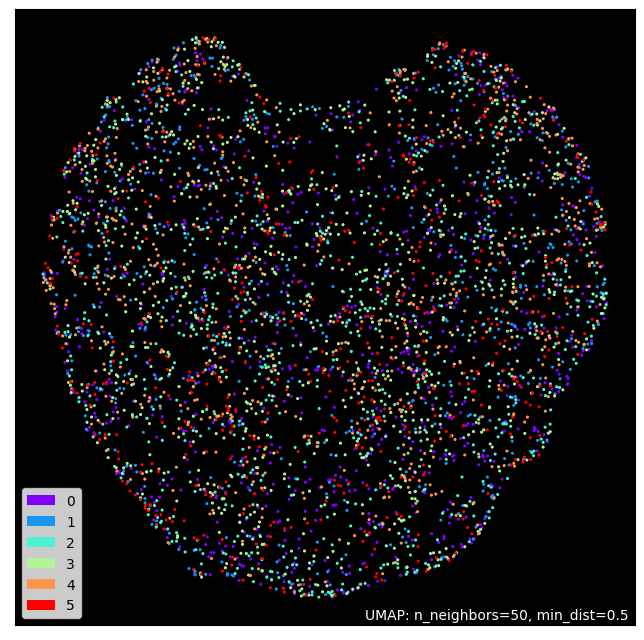 |
On the other hand, Spain's event projection on the 2-D manifold is rather uniform with respect to events in all matches. There exists once again some local purple neighborhoods, but claiming that this is a particular pattern for our match would rather be a stretch.


